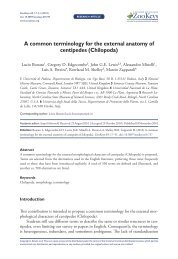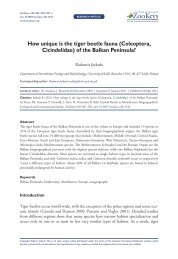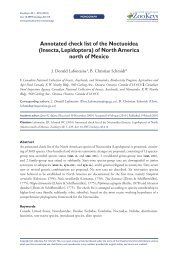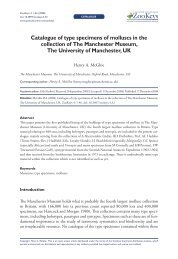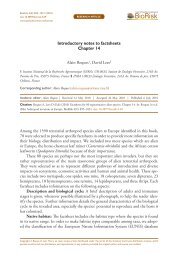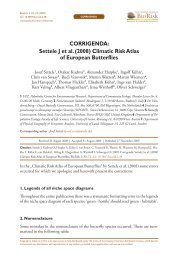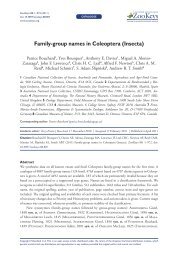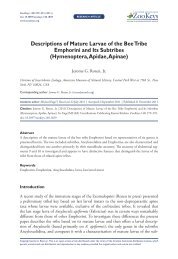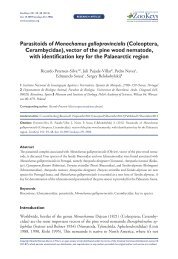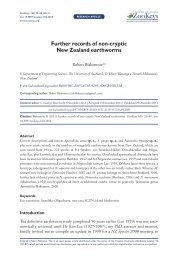Formicdubius Philips & Scholtz from South Africa, a junior synonym ...
Formicdubius Philips & Scholtz from South Africa, a junior synonym ...
Formicdubius Philips & Scholtz from South Africa, a junior synonym ...
Create successful ePaper yourself
Turn your PDF publications into a flip-book with our unique Google optimized e-Paper software.
ZooKeys 34: 41–48 (2010)<br />
doi: 10.3897/zookeys.34.342<br />
www.pensoftonline.net/zookeys<br />
<strong>Formicdubius</strong> <strong>Philips</strong> & <strong>Scholtz</strong> <strong>from</strong> <strong>South</strong> <strong>Africa</strong>, a <strong>junior</strong> <strong>synonym</strong> of Haroldius Boucomont...41<br />
<strong>Formicdubius</strong> <strong>Philips</strong> & <strong>Scholtz</strong> <strong>from</strong> <strong>South</strong> <strong>Africa</strong>,<br />
a <strong>junior</strong> <strong>synonym</strong> of Haroldius Boucomont, and a survey<br />
of the trichomes in the <strong>Africa</strong>n species<br />
(Coleoptera, Scarabaeidae, Onthophagini)<br />
Frank-Th orsten Krell 1 , T. Keith <strong>Philips</strong> 2<br />
1 Department of Zoology, Denver Museum of Nature & Science, 2001 Colorado Boulevard, Denver CO<br />
80205, U.S.A. 2 Department of Biology, Western Kentucky University, Bowling Green, KY 42101, U.S.A.<br />
Corresponding author: Frank-Th orsten Krell (frank.krell@dmns.org)<br />
Academic editor: Brett Ratcliff e | Received 26 November 2009 | Accepted 13 January 2010 | Published 28 January 2010<br />
Citation: Krell F-T, <strong>Philips</strong> TK (2010) <strong>Formicdubius</strong> <strong>Philips</strong> & <strong>Scholtz</strong> <strong>from</strong> <strong>South</strong> <strong>Africa</strong>, a <strong>junior</strong> <strong>synonym</strong> of Haroldius<br />
Boucomont, and a survey of the trichomes in the <strong>Africa</strong>n species (Coleoptera, Scarabaeidae, Onthophagini). In: Ratcliff e<br />
B, Krell F-T (Eds) Current advances in Scarabaeoidea research. ZooKeys 34: 41–48. doi: 10.3897/zookeys.34.342<br />
Abstract<br />
<strong>Formicdubius</strong> <strong>Philips</strong> & <strong>Scholtz</strong>, 2000, a genus of <strong>South</strong> <strong>Africa</strong>n scarab dung beetle, is <strong>synonym</strong>ised with<br />
Haroldius Boucomont, 1914. All four <strong>Africa</strong>n species of Haroldius, formerly in the genus Afroharoldius<br />
Janssens, possess trichomes. Trichome location and degree of development in the <strong>Africa</strong>n species are discussed.<br />
Th e fi rst record of Haroldius modestus Janssens <strong>from</strong> Malaŵi is given.<br />
Keywords<br />
Afrotropics, dung beetles, myrmecophiles, taxonomy<br />
Introduction<br />
RESEARCH ARTICLE<br />
A peer-reviewed open-access journal<br />
Launched to accelerate biodiversity research<br />
<strong>Philips</strong> and <strong>Scholtz</strong> (2000) described a new genus and species of a tiny, myrmecophilous<br />
Scarabaeinae, <strong>Formicdubius</strong> convexus (Figs 1–6), based on 16 specimens found in<br />
a nest of Pheidole megacephala (F.) ants collected in a suburb of Pretoria, <strong>South</strong> <strong>Africa</strong>.<br />
Th e circular and convex body shape and a length less than 2 mm resemble those in the<br />
Oriental Haroldius Boucomont, 1914, but the possession of trichomes was considered<br />
unique within Scarabaeinae.<br />
Copyright F-T. Krell, T.K. <strong>Philips</strong>. This is an open access article distributed under the terms of the Creative Commons Attribution License, which<br />
permits unrestricted use, distribution, and reproduction in any medium, provided the original author and source are credited.
42<br />
Frank-Th orsten Krell & T. Keith <strong>Philips</strong> / ZooKeys 34: 41–48 (2010)<br />
Th e genus Afroharoldius Janssens, 1949a, also of similar appearance, was classifi ed in<br />
the tribe Alloscelini or subtribe Alloscelina (Janssens 1949b; Ferreira 1972). Afroharoldius<br />
contained three species <strong>from</strong> central <strong>Africa</strong> but was <strong>synonym</strong>ised with Haroldius by<br />
Paulian (1985), because the only single diff erential diagnostic character, the number of antennomeres,<br />
was based on an incorrect observation. Janssens (1949a, b; 1953) erroneously<br />
claimed that Afroharoldius has nine antennomeres, but both Afroharoldius and Haroldius<br />
have eight antennomeres. Other characters diff erentiating these taxa remain unknown.<br />
Th e three former Afroharoldius species were overlooked for comparison when <strong>Formicdubius</strong><br />
was described. Furthermore, due to the earlier placement of this genus in the<br />
now unused “Alloscelina,” it was not included or studied in the revision of the southern<br />
<strong>Africa</strong>n “Canthonina” (<strong>Scholtz</strong> and Howden 1987). Recently, the resemblance of <strong>Formicdubius</strong><br />
with Haroldius and Afroharoldius became obvious and has already entered<br />
the scientifi c record in form of an “unpublished <strong>synonym</strong>y of <strong>Formicdubius</strong> <strong>Philips</strong> and<br />
<strong>Scholtz</strong> 2000” with Haroldius Boucomont (Davis et al. 2008: 216), which relates to<br />
the present paper, and Krikken and Huijbregts’ (2006: 168; 2009: 259) statement that<br />
<strong>Formicdubius</strong> should be placed in or near Haroldius. With this paper, we formalize the<br />
<strong>synonym</strong>y between <strong>Formicdubius</strong> with Haroldius.<br />
Tribal placement for Haroldius is unsettled. Although currently placed in the tribe<br />
Canthonini (Hanski and Cambefort 1991; Krikken and Huijbregts 2006), a preliminary<br />
phylogenetic analysis (<strong>Philips</strong> 2005) placed this taxon in the Onthophagini. Th is<br />
is also where <strong>Formicdubius</strong> was provisionally placed in <strong>Philips</strong> and <strong>Scholtz</strong> (2000).<br />
<strong>Africa</strong>n Haroldius species<br />
All <strong>Africa</strong>n species of Haroldius appear to have trichomes on the mesepimeron, the<br />
pronotal base, and the elytral base. Trichomes appear as distinct and relatively tight<br />
clusters of setae while others are looser or even single rows of thick setae such as those<br />
on the elytral base. Without microsections we are unable to decide whether those<br />
might be proper trichomes associated with glands or mechanoreceptors. However, as<br />
further evidence of a glandular association, longitudinal grooves at the pronotal base<br />
are also present that may facilitate the spreading of allomone secretions onto the pronotal<br />
surface, increasing the attractiveness of these beetles to their host ants.<br />
<strong>Formicdubius</strong> convexus (Figs 1–6) (and the very similar or conspecifi c Haroldius<br />
leleupi Janssens, 1953; Figs 11–13) can easily be distinguished <strong>from</strong> the remaining Haroldius<br />
species by the presence of a distinct notch between the pronotum and the elytral<br />
base accommodating the pronotal trichomes (Figs 2, 12). In Haroldius ennearthrus<br />
Janssens, 1949 (Figs 14–19), the basal margins of pronotum and elytra are straight<br />
with the pronotal margin slightly emarginate close to the edge (Figs 15, 18); a notch is<br />
missing, but a slight lateral depression towards the bases of the pronotum and elytra is<br />
visible. H. modestus Janssens, 1953 shares the general shape of the pronotal and elytral<br />
bases with H. ennearthrus but the pronotal margin is slightly more strongly emarginate<br />
laterally (Figs 8–9).
<strong>Formicdubius</strong> <strong>Philips</strong> & <strong>Scholtz</strong> <strong>from</strong> <strong>South</strong> <strong>Africa</strong>, a <strong>junior</strong> <strong>synonym</strong> of Haroldius Boucomont...43<br />
1 2<br />
0.5 mm<br />
3 4<br />
5 6<br />
Figures 1–6. Haroldius convexus: 1 Dorsal habitus 2 Trichomes within cleft between prothorax and<br />
mesothorax and showing pronotal sulci 3 SEM (scanning electron microscope) view of pronotal trichome<br />
4 SEM view of pronotal trichome showing possibly ant-gnawed tips of the setae 5 SEM view of possible<br />
trichomes on the elytral base 6 SEM view of trichome on the mesepisternum and additional setal row<br />
proximally.
44<br />
Frank-Th orsten Krell & T. Keith <strong>Philips</strong> / ZooKeys 34: 41–48 (2010)<br />
Th e trichomes on these species are located on the mesepisternum anterolaterally,<br />
the elytra anterolaterally (on the vertical surface facing the pronotum), and on the<br />
pronotal base posterolaterally. One should be aware that these setae may be damaged<br />
<strong>from</strong> the eff ects of gnawing by their host ants and the actual number of setae may vary<br />
in number more than we report due to our limited sample sizes. Regardless, the degree<br />
of development of these structures in each species is as follows:<br />
Specimens of H. ennearthrus possess a large rounded cluster of setae on the<br />
mesepisternum (Fig. 19) and no additional setae proximally. Th ey also appear to have<br />
two short and relatively thick setae on the elytral base. Th ree to fi ve thick setae are<br />
present on the pronotum (Figs 16–18) as well as a row of similar aligned setae proximal<br />
to these, all of which may be trichomes (Fig. 16).<br />
Haroldius modestus (Figs 7–10) also has a large, rounded cluster of setae on the<br />
mesepisternum (Fig. 10) and lacks any thick setae proximally. Th ere are two to three<br />
thick setae on the elytral base. On the pronotum a brush-like trichome is well developed,<br />
consisting of six to sometimes ten or more, long, thick setae (Figs 8–9).<br />
Th e third described Haroldius species <strong>from</strong> <strong>Africa</strong>, H. leleupi (Figs 11–13), is<br />
strikingly similar to <strong>Formicdubius</strong> convexus (Figs 1–6). Th ey both have a small cluster<br />
of stout setae on the mesepisternum (Figs 6, 13) and proximal to this are a few<br />
more thick and elongate setae arranged in a transverse row (Fig. 6). Th ese same<br />
setae become more slender and slightly more widely separated the further <strong>from</strong> the<br />
mesepisternal trichome. Additionally, there are four to fi ve short, thick setae at the<br />
base of the elytra near the lateral margin (Fig. 5). Both species also have a well developed<br />
trichome on the pronotal base consisting of 20 or more lobe shaped setae<br />
(Figs 3–4, 12–13).<br />
We are unsure whether H. leleupi and F. convexus are distinct taxa. H. leleupi is<br />
generally larger; the fi ve specimens studied measure 1.80–2.20 mm in length (average<br />
2.06 mm), whereas the 14 sampled types of F. convexus measure 1.63–1.90 mm (average<br />
1.78 mm). Haroldius leleupi also has slightly stronger (more clearly defi ned) punctures<br />
on the disk of the pronotum and the elytral intervals and slightly deeper elytral<br />
striae, particularly near the suture. Additional material will be required <strong>from</strong> localities<br />
between the Congo and <strong>South</strong> <strong>Africa</strong> to decide to what extent these minor diff erences<br />
indicate taxonomic diff erentiation.<br />
Synonymy<br />
Haroldius leleupi and <strong>Formicdubius</strong> convexus are diffi cult to distinguish at the species<br />
level, but there is no doubt that <strong>Formicdubius</strong> is identical with Haroldius at the generic<br />
level. <strong>Formicdubius</strong> fully matches Boucomont’s (1914) original description of<br />
Haroldius. It also agrees with the extended diagnosis of Haroldius recently published<br />
by Krikken and Huijbregts (2006) with the exception that all <strong>Africa</strong>n species currently<br />
subsumed under Haroldius possess trichomes.
<strong>Formicdubius</strong> <strong>Philips</strong> & <strong>Scholtz</strong> <strong>from</strong> <strong>South</strong> <strong>Africa</strong>, a <strong>junior</strong> <strong>synonym</strong> of Haroldius Boucomont...45<br />
7 8<br />
9<br />
0.5 mm<br />
Figures 7–13. Haroldius species. Figures 7–10. H. modestus 7 Dorsal habitus 8 Trichomes within cleft<br />
between prothorax and mesothorax and showing pronotal sulci 9 Pronotal trichome 10 SEM view of<br />
trichomes on the pronotum and mesepisternum. Figures 11–13. Haroldius leleupi: 11 Dorsal habitus<br />
12 Trichomes within cleft between prothorax and mesothorax and showing pronotal sulci 13 SEM view<br />
of trichomes on the pronotum and mesepisternum.<br />
10<br />
11 12<br />
13<br />
0.5 mm
46<br />
Frank-Th orsten Krell & T. Keith <strong>Philips</strong> / ZooKeys 34: 41–48 (2010)<br />
We propose the following <strong>synonym</strong>y:<br />
Haroldius Boucomont, 1914 (type species by subsequent designation by Arrow,<br />
1931: Haroldius rugatulus Boucomont, 1914)<br />
= <strong>Formicdubius</strong> <strong>Philips</strong> & <strong>Scholtz</strong>, 2000 (type species by original designation: <strong>Formicdubius</strong><br />
convexus <strong>Philips</strong> & <strong>Scholtz</strong>, 2000), syn. n.<br />
Consequently, the following new combination is established:<br />
Haroldius convexus (<strong>Philips</strong> & <strong>Scholtz</strong>, 2000) Krell & <strong>Philips</strong>, 2010, comb. n.<br />
We refrain <strong>from</strong> determining the taxonomic status of the <strong>Africa</strong>n species of the<br />
Haroldius/Afroharoldius group. All <strong>Africa</strong>n Haroldius species have more or less distinct<br />
trichomes which could be a synapomorphy justifying a genus or subgenus Afroharoldius.<br />
However, we neither know if trichomes (vestigial or distinctive) are common in<br />
Asian Haroldius species, or whether the trichome-bearing species are the sister group<br />
of the trichome-less Haroldius, or whether their exclusion <strong>from</strong> Haroldius would leave<br />
Haroldius or Afroharoldius paraphyletic. In Haroldius brendelli Krikken & Huijbregts,<br />
antehumeral elytral trichomes are described (Krikken and Huijbregts 2009). Based<br />
on the illustrations in Krikken and Huijbregts (2006), it appears as though pronotal<br />
grooves are present on at least some Asian species and, moreover, trichomes seem to be<br />
present in H. tangkoko Krikken & Huijbregts and H. cambeforti Krikken & Huijbregts<br />
(see their fi gs 5 and 6). A revision and phylogenetic analysis of the whole group, including<br />
species of Phaedotrogus Paulian and probably Ponerotrogus Silvestri and Cyclotrogus<br />
Wasmann (both currently considered to be <strong>junior</strong> <strong>synonym</strong>s of Haroldius), will<br />
probably be necessary to establish a sound genus-level classifi cation. Currently we see<br />
no reason to change the status of Afroharoldius as <strong>junior</strong> <strong>synonym</strong> of Haroldius.<br />
Material studied<br />
40 Afrotropical Haroldius specimens <strong>from</strong> the following collections were studied:<br />
BMNH Th e Natural History Museum, London, UK.<br />
MRAC Musée Royal de l’Afrique Centrale, Tervuren, Belgium.<br />
TKPC T. Keith <strong>Philips</strong> Collection, Western Kentucky University, Bowling Green,<br />
USA.<br />
Haroldius ennearthrus (7 spm.): Holotype: DR Congo, Katanga, Elisabethville [Lubumbashi],<br />
“dans petites termitières”, leg. N. Leleup 3.i.1949 [MRAC]. Additional<br />
material: 6 spm. Kasai [now Lulua Province], Luluabourg [Kananga], “Récolté<br />
sous des pierres (avec fourmis)”, leg. N. Leleup 3.ii.1953 (det. Janssens) [MRAC].<br />
Haroldius modestus (22 spm.): Holotype: DR Congo, Katanga, Kundelungu, 1750m,<br />
“savane herb.”, “Myrmécophile”, leg. N. Leleup 23.iii.1950 [MRAC]. Paratypes:<br />
1 spm., Massif des Kundelungu, leg. N. Leleup 7.ii.1950, “Rives d’une mare”,<br />
“Récolté dans pet. fourmilière”; 5 spm., dto., 1750 m, ii.1950, “savane herbeuse”,<br />
“Récolté dans petite fourmilière”; 1 spm., dto., 18.ii.1950; 8 spm., same data as<br />
holotype; 1 spm., 4.iii.1950, “Rives d’une mare”, “Myrmécophile”; 1 spm., dto.,
<strong>Formicdubius</strong> <strong>Philips</strong> & <strong>Scholtz</strong> <strong>from</strong> <strong>South</strong> <strong>Africa</strong>, a <strong>junior</strong> <strong>synonym</strong> of Haroldius Boucomont...47<br />
14 15<br />
Figures 14–19. Haroldius ennearthrus: 14 Dorsal habitus 15 Trichomes within cleft between prothorax and<br />
mesothorax and showing pronotal sulci 16 Pronotal trichome and adjacent setae 17 Close-up view of trichome<br />
on the pronotum 18 SEM view of trichome on the pronotum 19 SEM view of trichome on the mesepisternum.<br />
10.iii.1950; 1 spm., dto., 20.iii.1950, “Récolté dans pet. fourmilière”; 1 spm., dto.<br />
24.iv.1950, “Myrmécophile”, “savane – parc’; 1 spm., dto., “savane boisée”, “Récolté<br />
sous écorce d’arbre” [MRAC]. Additional material: 1 spm., Malaŵi, Chisasira<br />
(Chinteche), leg. R. Jocqué 3.i.1978 [MRAC], new record for Malaŵi.<br />
Haroldius leleupi (5 spm.): Holotype: DR Congo, Katanga [now in Lualaba Province],<br />
Kanzenze, “Récolté dans fourmilière”, leg. N. Leleup 5.ii.1949 [MRAC]. Paratypes:<br />
4 spm., dto., 12.ii.1949 [MRAC].<br />
Haroldius convexus (6 spm.): Paratypes: <strong>South</strong> <strong>Africa</strong>, Pretoria, Th e Willows, 25°45'S,<br />
28°21'E, under stone with Pheidole megacephala (F.) [det. H.G. Robertson], leg. R.<br />
Oberprieler 1.i.1996 [2 spm. BMNH, 1 spm. MRAC, 3 spm. TKPC].<br />
Acknowledgements<br />
0.5 mm 100 μm<br />
16 17 18 19<br />
We are grateful to Marc De Meyer, Royal Museum of Central <strong>Africa</strong>, Tervuren, and to<br />
Malcolm Kerley, Th e Natural History Museum, London, for their patience with our<br />
extended loan of <strong>Africa</strong>n Haroldius specimens. Jan Krikken, Leiden, and and Tristão<br />
Branco, Porto, helped to improve this paper.
48<br />
References<br />
Frank-Th orsten Krell & T. Keith <strong>Philips</strong> / ZooKeys 34: 41–48 (2010)<br />
Arrow GJ (1931) Th e Fauna of British India including Ceylon and Burma, Coleoptera, Lamellicornia,<br />
Part III. (Coprinae). Taylor and Francis, London, 428 pp., 13 pls, 1 map.<br />
Boucomont A (1914) Les coprophages de l’Archipel Malais. Annales de la Société Entomologique<br />
de France 83: 238–350.<br />
Davis ALV, Frolov AV, <strong>Scholtz</strong> CH (2008) Th e <strong>Africa</strong>n Dung Beetle Genera. Protea Book<br />
House, Pretoria, 272 pp.<br />
Ferreira MC (1972) Os escarabídeos de África (sul do Sáara). I. Revista de Entomologia de<br />
Moçambique 11: 5–1088.<br />
Hanski I, Cambefort Y (Eds) (1991) Dung Beetle Ecology. Princeton University Press, Princeton,<br />
MA, xiii, 481 pp.<br />
Janssens A (1949a) Un Scarabaeinae termitophile nouveau du Congo belge. Revue de Zoologie<br />
et de Botanique <strong>Africa</strong>ines 42: 183–184.<br />
Janssens A (1949b) Contribution à l’étude des coléoptères Lamellicornes. XIII. – Table synoptique<br />
et essai de classifi cation pratique des Coléoptéres Scarabaeidae. Bulletin, Institut<br />
Royal des Sciences Naturelles de Belgique 25(15): 1–30.<br />
Janssens A (1953) Contribution à l’étude des Coléoptères Lamellicornes d’Afrique II. Espèces<br />
nouvelles du genre Afroharoldius A. Janssens. Revue de Zoologie et de Botanique <strong>Africa</strong>ines<br />
47: 344–347.<br />
Krikken J, Huijbregts J (2006) Miniature scarabs of the genus Haroldius on Sulawesi, with notes<br />
on their relatives (Coleoptera: Scarabaeidae). Tijdschrift voor Entomologie 149: 167–187.<br />
Krikken J, Huijbregts J (2009) A new Haroldius Boucomont and a new Tesserodon Hope <strong>from</strong><br />
the Moluccas (Coleoptera: Scarabaeidae: Scarabaeinae). Koleopterologische Rundschau<br />
79: 257–266.<br />
Paulian R (1985) Notes sur les Coléoptères Scarabaeidae du Muséum de Genève. II. Revue<br />
Suisse de Zoologie 92: 189–203.<br />
<strong>Philips</strong> K (2005) Phylogeny of the oniticelline and onthophagine scarabaeine dung beetles.<br />
2005 ESA Annual Meeting, December 15–18, 2005, Ft. Lauderdale, FL; abstract and<br />
poster handout at http://esa.confex.com/esa/2005/techprogram/paper_20479.htm [accessed<br />
2 Oct. 2009].<br />
<strong>Philips</strong> TK, <strong>Scholtz</strong> CH (2000) A new genus and species of trichome-bearing dung beetle (Coleoptera:<br />
Scarabaeidae: Scarabaeinae) <strong>from</strong> <strong>South</strong> <strong>Africa</strong>. <strong>Africa</strong>n Entomology 8: 227–231.<br />
<strong>Scholtz</strong> CH, Howden HF (1987) A revision of the <strong>Africa</strong>n Canthonina (Coleoptera: Scarabaeidae:<br />
Scarabaeinae). Journal of the Entomological Society of <strong>South</strong>ern <strong>Africa</strong> 50: 75–119.



